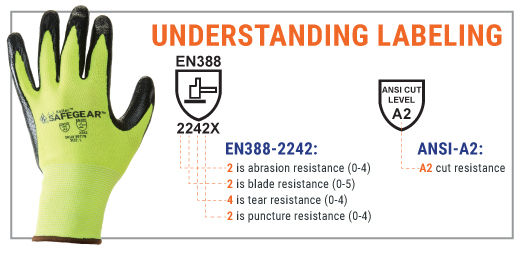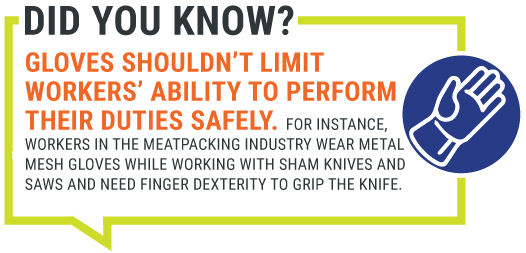December 2022
Safety Gloves: No Shortcuts Allowed!

Your workers use their arms and hands to perform pulling and lifting movements every day. If they injure their hands or arms and lose the ability to use them, it would significantly impact the quality of their lives. Yet 30% of all workplace injuries involve cuts or lacerations. (Bureau of Labor Statistics)


How Can Cut-resistant Gloves Help?
With 70% of cuts and lacerations occurring to workers’ hands and fingers (Bureau of Labor Statistics), cut-resistant gloves are essential in most industries. Remember, cut-resistant gloves are not cut-proof but are made and tested to resist a cut from a blade or sharp object. A higher cut rating means that the glove material resisted higher cutting force during testing.
Cut Resistance By The Numbers
What do all those numbers mean that are imprinted on cut-resistant rated work gloves? They correlate to how resistant the gloves are to abrasions, cuts, tears, or punctures.

In 2016, ANSI expanded its five cut-level protections into four additional categories under its ANSI/ISEA 105 standard, Hand Protection Selection Criteria. These additional categories are A6 through A9. You’ll also see an EN 388 infographic on cut-resistant gloves. Like ANSI 105, an EN 388 cut rating correlates with cut resistance levels used outside the United States in the European Union Countries. In North America, though, ANSI 105 cut resistance ratings are used.

Level Up!
See the chart above to see what cut level is suitable for your workers’ specific tasks. Here's a general breakdown of the various levels and their cut resistance.
- Level A1 is rated for light-cut hazards up to 200 grams cut force resistance.
- Levels A2 through A4 gloves offer protection from light/medium-cut hazards with 500-1,500 grams cut force resistance.
- Level A5 is rated for medium-cut hazards and cut force resistance of 2,200 grams.
- Levels A6 through A9 offer protection from high-cut hazards and cut force resistance of 3,000-6,000 grams.

What's Up Your Sleeve?
Wearing cut-resistant arm sleeves is a great way to protect your arms from sharp objects. Worn with cut-resistant gloves, they extend protection from the wrist to above the elbow. Those made with moisture-wicking material can help keep your workers more comfortable throughout the day.

Maximum Protection
Perform a PPE assessment to determine which types of hand and arm PPE will offer your workers adequate protection from cuts and lacerations. Then, be sure to care for it by cleaning it and inspecting it regularly for changes in shape, hardening, stretching, or rips. You can't afford to take shortcuts with hand protection!